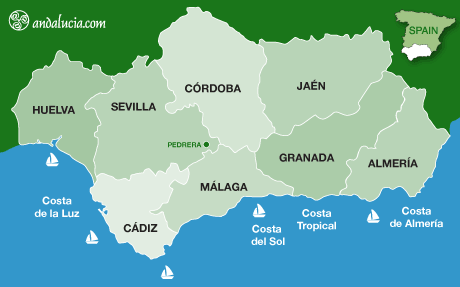PEDRERA
by Saskia Mier
Pedrera hosts one of Seville's most important carnivals. The special entierro de la sardina (burying of the sardine) is a pilgrimage towards the Cruz Sierra. The town has about 5,300 inhabitants.
HISTORY
The origin of Pedrera dates to the Chalcolithic period and it was named Barba during the Phoenician era. It seems to have already been established as a stable settlement under Roman rule, renamed Ilipula Minor and dedicated to agricultural use of the land. The settlement remained active during the Visigoth period.
During Arab domination, the village was reduced to a farmhouse, joining Estepa after the re-conquest. The name Pedrera dates to the Middle Ages when the town became a bullet supplier for the first artillery cannons that used stone ammunition, gaining a reputation in this area for the excellent quality of its quarries dedicated to the development of these projectiles. Some also suggest that the quarries of Pedrera were used to extract the necessary material for the restoration of the Estepa Castle and construction of the road that led from Estepa to Seville.
In 1557, Pedrera obtained royal privilege to obtain its own City Council. Later, in 1837, when the Jurisdictional Lordships were abolished, it no longer belonged to the Marquesado de Estepa, and became a Constitutional City Council.
THINGS TO SEE
Iglesia de San Sebastián
The church dates to the sixteenth century and consists of a tower on the left side decorated with moulding work and five bodies topped in a pyramidal spire built in brick. The interior contains a main neoclassical altarpiece with images dating to the second half of the eighteenth century made by Sebastián Santos, Álvarez Duarte and Francisco S. Requema (1897). Located in Plaza de Guzmán y Andrés.
Ermita del Santo Cristo de la Sangre
The chapel is named after the crucified Christ that it holds in its interior. According to legend, this Christ of the Blood passed through the town on the way to Antequera from Seville, where it had been made in paste. When passing by, the cart pulled by oxen was stuck and the chapel was built to prevent it leaving the town. It dates from the sixteenth century and was reformed in the eighteenth century. Located on Calle Santo Cristo.
Ermita del Carmen
The chapel dates to the eighteenth century and is built with revoked masonry. The main altarpiece contains pieces from the second third of the eighteenth century. On 16 July, the Virgen del Carmen leaves in procession from this hermitage, followed by the women of the town. Located on Calle Primera de Mayo.
Casa Señoriales
The town has a variety of manor houses, originally typical farm-houses,along witha hospital dating to the seventeenth century.
Hotels near Pedrera
Book Hotels near Pedrera
NATURAL AREAS
Sierra de la Cruz
A natural area located in the region of the Sierra Surthatbelongs to the Sevillian subbética, extending through the municipalities of Estepa and Pedrera. In 2004, the idea was to exploit a quarry in this area, but it was opposed by the locals, who mounted a short film against the project called "El Grito de la Sierra", co-directed by Oliver Ojeda, José Joaquín Pachón and Salvador Gómez, residents of Pedrera. It is here that the pilgrimage on Carnival Sunday is celebrated.
Fuente de la Higuera
The Fuente de la Higuera is a Riviera of orchards consisting of five plots of about two fanegas (an old measure of dry capacity) of land, which depended on the water fromthis source - originating under a fig tree and initially conducted through a stream towards a large pool, where it was bottled. From this pool the plots were irrigated regularly according to the needs of each one.Next to the fountain an esplanade was used as a resting place for cattle. Today it is used as a picnic area. Located about two kilometres from Pedrera and two kilometres from Gilena.
Arroyo del Búho
It is said that the water found in this stream is ideal for treating skin conditions, and so you will find several inhabitants collecting the water to heal wounds and purify their bodies. In this area, along with others in the municipality, public initiatives are being undertaken to convert them into adequate spaces for future rural tourism.
GASTRONOMY
When visiting Pedrera, try their local dishes such as tortas de mateca (sweet torts usually made during winter), tortillitas de bacalao (cod fritters), salmorejo (cold tomato soup) andliebre con arroz (hare with rice), along with chorizos y morcillas (chorizo and black pudding). One must not forget the local olive oil, which in 2006 won the award for the best olive oil in Spain and will be a main ingredient in all the dishes.
HANDICRAFTS
Local crafts still produced in the town are carpentry and stonework.
FESTIVALS
Cabalgata Reyes Magos
Three Kings procession celebrated on the evening of 5 January.
Fiesta de la Candelaria
Celebrated on1 February.
Día de Andalucía
Celebrated on 28 February.
Carnaval
Celebrated 40 days before Resurrection Sunday.
Romería
Celebrated on the Sunday before Ash Wednesday.
Semana Santa
Holy Week.
Fiesta de San Antonio de Padua
Celebrated on 13 June.
Feria de Agosto
Celebrated the last week of August.
NEIGHBOURING VILLAGES
The nearby villages to Pedrera are Gilena, Aguadulce and La Roda de Andalucía.

